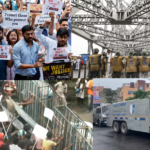Introduction
Kolkata, a city steeped in history and culture, is no stranger to protests and social movements. The recent Kolkata protests, however, have captured national attention due to their intensity and the tragic events that have triggered them. The death of a 31-year-old postgraduate trainee doctor at RG Kar Medical College has ignited a series of Kolkata protests that have spread across the city, culminating in the Nabanna Abhijan march. This article delves into the developments, background, and implications of these Kolkata protests, providing a comprehensive analysis of the situation.
Background of the Kolkata Protests
Kolkata Protests: The RG Kar Medical College Incident
The roots of the current unrest in Kolkata can be traced back to the tragic incident at RG Kar Medical College, where a 31-year-old postgraduate trainee doctor was raped and murdered. The brutality of the crime shocked the city and the nation, leading to an outpouring of grief and anger. The medical community, in particular, was deeply affected, as the victim was one of their own. The incident highlighted issues of safety and security within educational institutions, particularly those catering to medical students, who often work long hours in demanding and stressful environments.

Kolkata Protests: Historical Context of Student Protests in Kolkata
Kolkata has a rich history of student activism, with movements dating back to the pre-independence era. The city has often been a battleground for ideological clashes, with students playing a pivotal role in shaping political discourse. The Nabanna Abhijan protest, although sparked by the recent incident at RG Kar Medical College, fits into this broader tradition of student activism in Kolkata. Understanding this historical context is crucial to comprehending the motivations and significance of the current protests.
The Nabanna Abhijan Protest : Kolkata Protests
Kolkata Protests: Organization and Objectives
The Nabanna Abhijan protest was organized by an unregistered students’ organization, which has not yet been officially recognized. The primary demand of the protesters was justice for the victim of the RG Kar Medical College incident. However, the protest also called for broader accountability in the case, including transparency in the investigation and the prosecution of those responsible. The protest was named after Nabanna, the state secretariat of West Bengal, symbolizing the demand for direct accountability from the highest levels of government.
Kolkata Protests: The Significance of Nabanna as a Focal Point
Nabanna, the state secretariat, is not just a government building; it represents the political nerve center of West Bengal. It houses the offices of the Chief Minister and other top ministers and officials, making it a symbolic target for protests aimed at the government. The choice of Nabanna as the focal point for the protest underscored the protesters’ demand for attention and action from the highest levels of state authority.
The Day of the Protest: A Detailed Account
Kolkata Protests: Security Arrangements and Initial Standoff
Given the potential for unrest, the Kolkata Police made extensive security arrangements in anticipation of the Nabanna Abhijan protest. Barricades were set up at key points across the city, particularly around Nabanna. The police were prepared for a large turnout and the possibility of clashes, given the emotional and charged nature of the protest.
As the march progressed, tensions began to rise. The protesters, driven by their anger and frustration, attempted to break through the police barricades. The situation quickly escalated, leading to a standoff between the protesters and the police.
The Use of Tear Gas and the Escalation of Violence
As the standoff continued, the situation spiraled out of control. The police, in an effort to disperse the crowd, resorted to using tear gas shells. This only served to inflame the protesters further, leading to chaotic scenes across the city. The use of tear gas is often a last resort in crowd control, and its deployment highlighted the severity of the situation.
The clash between the protesters and the police resulted in several injuries, both among the protesters and the law enforcement personnel. The images of the violence that emerged from the scene were reminiscent of previous instances of civil unrest in the city, drawing parallels to past protests that had similarly escalated into violence.
The Controversy Surrounding the Transfer of Professors and Doctors : Kolkata Protests
Kolkata Protests: Government Response and Public Backlash
Amid the growing unrest, the West Bengal government made the controversial decision to transfer 42 professors and doctors from various medical colleges and hospitals across the state. This move was seen by many as an attempt to diffuse the situation and mitigate further protests by disrupting the medical community’s cohesion. However, it had the opposite effect, sparking further outrage.
The transfer of medical professionals in the midst of such a crisis was viewed as a heavy-handed tactic by the government, aimed at silencing dissent within the medical community. The move was widely criticized by opposition parties, student organizations, and civil society groups, who accused the government of attempting to stifle legitimate protests and demands for justice.
Kolkata Protests: The Impact on Medical Education and Healthcare Services
The transfer of professors and doctors also had significant implications for medical education and healthcare services in the state. With key personnel being relocated, the functioning of several medical colleges and hospitals was disrupted. This had a direct impact on patient care, with reports of delays in medical services and surgeries being postponed.
The controversy surrounding the transfers added another layer of complexity to the ongoing protests, with the medical community finding itself at the center of a political and social storm.
The Reclaim the Night Protest: A Night of Chaos
Kolkata Protests: The Concept and Objectives of Reclaim the Night
The “Reclaim the Night” protest is part of a global movement advocating for women’s safety and the right to move freely without fear of violence. In the context of Kolkata, the protest was organized to demand safer environments for women, particularly in public spaces and institutions. The protest was also a response to the RG Kar Medical College incident, with participants demanding justice for the victim and calling for broader systemic changes to ensure women’s safety.
Kolkata Protests: The Incident at RG Kar Medical College and the Use of Tear Gas
During the Reclaim the Night protest, chaos erupted as a mob entered RG Kar Medical College and Hospital. The situation quickly escalated, leading to clashes between the protesters and security personnel. In an attempt to control the situation, the police once again resorted to using tear gas.
The use of tear gas in a medical college, where patients and medical staff were present, drew widespread condemnation. The clashes resulted in several injuries, adding to the already tense atmosphere in the city. The incident underscored the deep-seated anger and frustration among the protesters, as well as the challenges faced by the authorities in managing the situation.
The Symbolism of Howrah Bridge and the City’s Daily Life : Kolkata Protests
Howrah Bridge: A Symbol of Resistance
The iconic Howrah Bridge, a symbol of Kolkata’s identity, became a focal point for protesters. The bridge, which connects the city of Kolkata with Howrah, is more than just a physical structure; it represents the lifeline of the city. By gathering at Howrah Bridge, the protesters were making a statement about the interconnectedness of their cause with the city’s identity.
The choice of Howrah Bridge as a protest site was also symbolic of the protesters’ desire to disrupt the normal functioning of the city, forcing the authorities and the public to pay attention to their demands.
Kolkata Protests: The Stark Contrast of Daily Horoscopes and Unrest
Amidst the chaos and violence, the continued publication of daily horoscopes in local newspapers provided a stark contrast to the unfolding events. Horoscopes, a routine part of daily life for many, represented the normalcy that still persisted in the city despite the unrest. This contrast highlighted the resilience of the city’s residents, who continued with their daily lives even as the city was gripped by protests.
However, the continued focus on horoscopes also raised questions about the media’s role in covering the protests. Some critics argued that the media was downplaying the severity of the situation by continuing to publish routine content alongside reports of the unrest.
The Ongoing Strike by Doctors
Kolkata Protests: The Medical Community’s Response to the Incident
The death of the postgraduate trainee doctor at RG Kar Medical College had a profound impact on the medical community in Kolkata. Doctors across the city, and even in other parts of the state, began an indefinite strike to demand justice for their colleague. The strike was not just a reaction to the incident but also a broader protest against the unsafe working conditions and lack of security for medical professionals.
The striking doctors received support from various quarters, including student organizations, civil society groups, and political parties. However, the strike also faced criticism from some sections of the public, who were concerned about the impact on patient care.
Kolkata Protests: The Government’s Appeals and the Doctors’ Stand
Kolkata Protests: The Government’s Appeals and the Doctors’ Stand In response to the strike, the West Bengal government made several appeals to the doctors to end their protest. The government assured the medical community that the incident would be thoroughly investigated and that those responsible would be brought to justice. However, these assurances were met with skepticism by the doctors, who refused to call off the strike until concrete action was taken.
The standoff between the doctors and the government added another layer of complexity to the situation. While the doctors’ demands were seen as legitimate, the prolonged strike also had a significant impact on healthcare services in the city. The government faced mounting pressure to find a resolution that would address the doctors’ concerns while also ensuring that patient care was not compromised.
Political and Social Implications of the Protests
Kolkata Protests: The Role of Opposition Parties
The protests in Kolkata have also had significant political implications. Opposition parties in West Bengal have seized upon the unrest to criticize the ruling Trinamool Congress (TMC) government. The opposition has accused the government of failing to ensure the safety of women and medical professionals and has called for the resignation of key ministers.
The protests have provided the opposition with an opportunity to galvanize public support and challenge the TMC’s dominance in the state. The political ramifications of the protests are likely to be felt in the upcoming elections, with both the ruling party and the opposition seeking to capitalize on the situation.

The Broader Social Impact
Beyond the immediate political implications, the protests have also had a broader social impact. The incident at RG Kar Medical College has sparked a wider conversation about women’s safety, particularly in educational and professional settings. The protests have highlighted the need for systemic changes to ensure that women can work and study in safe environments.
The unrest has also drawn attention to the challenges faced by the medical community, including long working hours, inadequate security, and the pressure of working in a high-stress environment. The protests have served as a wake-up call for the authorities to address these issues and ensure that medical professionals are provided with the support and protection they need.
Conclusion
The protests in Kolkata, triggered by the tragic incident at RG Kar Medical College, have brought to the forefront issues of safety, accountability, and justice. The Nabanna Abhijan protest, the Reclaim the Night movement, and the ongoing strike by doctors are all part of a broader struggle for systemic change in the city and the state. As the situation continues to evolve, the protests have already left a lasting impact on Kolkata’s social and political landscape.
The response of the government, the involvement of opposition parties, and the resilience of the medical community will all play a crucial role in shaping the outcome of this unrest. As Kolkata grapples with these challenges, the city once again finds itself at the center of a movement for justice and change.
Learn more











More Stories
Dynamic Duo 2024: A Tale of Two Stars: Aditi Rao Hydari and Siddharth
NEET PG 2024 Results Released: Celebrating Success in Medical Education
PM Modi’s Cabinet Approves Revolutionary Unified Pension Scheme 2024: What You Need to Know